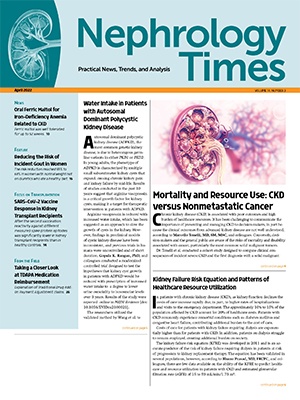
Autosomal dominant polycystic kidney disease (ADPKD), the most common genetic kidney disease, is due to heterozygous germline variants in either PKD1 or PKD2. In young adults, the phenotype of ADPKD is characterized by multiple small subcentimeter kidney cysts that expand, causing chronic kidney pain and kidney failure by mid-life. Results of studies conducted in the past 10 years suggest that arginine vasopressin is a critical growth factor for kidney cysts, making it a target for therapeutic intervention in patients with ADPKD.
Arginine vasopressin is reduced with increased water intake, which has been suggested as an approach to slow the growth of cysts in the kidney. However, findings in preclinical models of cystic kidney disease have been inconsistent, and previous trials in humans were uncontrolled and of short duration. Gopala K. Rangan, PhD, and colleagues conducted a randomized controlled trial designed to test the hypotheses that kidney cyst growth in patients with ADPKD would be reduced with prescription of increased water intake to a degree to lower urine osmolality to iso-osmolar levels over 3 years. Results of the study were reported online in NEJM Evidence [doi: 10.1056/EVIDoa2100021].
The researchers utilized the validated method by Wang et al. to prescribe and personalize the amount of water needed to suppress urine osmolality. Based on a systematic review of methods to increase water intake, the study intervention was implemented using a multipronged approach, including coaching and tools for self-monitoring.
The study, PREVENT-ADPKD (Randomized Controlled Trial to Determine the Efficacy and Safety of Prescribed Water Intake to Prevent Kidney Failure Due to Autosomal Dominant Polycystic Kidney Disease), was an investigator-initiated, 3-year trial conducted at 13 centers in Australia from December 2015 to June 2021. Inclusion criteria were age 18 to 67 years, diagnosis of ADPKD, estimated glomerular filtration rate (eGFR) of ≥30 mL/min/1.73 m2, height-corrected total kidney volume in Mayo imaging subclass categories 1B to 1E, and provision of written consent.
Key exclusion criteria were presence of potential safety risk for increased water intake, a contraindication to undergoing magnetic resonance imaging (MRI), a subjective risk of noncompliance with study procedures, comorbid conditions with the potential to confound end point measures, and/or participation in other clinical trials. Due to the risk of hyponatremia, diuretics were completely withdrawn (in consultation with the treating nephrologist) in eligible patients who were willing to participate in the study.
The primary end point was the annualized rate of change (slope) in height-corrected total kidney volume from baseline to month 18 and to month 36 (normalized as a percentage). Secondary end points were surrogate markers of systemic arginine vasopressin activity, progression of kidney disease (slope of decline in eGFR from baseline and 3 months to 36 months, mean arterial pressure, and spot urine albumin-to-creatinine ratio), kidney pain, and a composite end point of kidney disease progression (≥25% reduction in eGFR from baseline or week 12, worsening hypertension, worsening albuminuria, and clinically significant kidney pain), a physiological measure of treatment adherence, and treatment acceptability.
During the period December 2015 until June 2017, 1571 patients were screened for eligibility. Of those, 276 gave permission for study participation and attended the first visit for screening. A total of 187 patients met the eligibility criteria; three did not attend the randomization visit. The remaining 184 were randomly assigned to the water ad libitum group (n=92) or prescribed water intake group (n=92). Of the total cohort, 85.9% (n=158/184) completed the 3-year follow-up: 88.0% in the ad libitum water intake group and 83.7% in the prescribed water intake group. All 184 patients were included in the analysis of the primary and secondary end points.
The two groups were similar in demographic, clinical, and laboratory characteristics. At baseline, mean 24-hour urine osmolality and median 24-hour urine volume of the total cohort were 432 mOsmol/kg and 2253 mL, respectively.
Over the 3 years of the study, median absolute changes in height-corrected total kidney volume per year were 55.0 mL/m in the ad libitum water intake group and 39.0 mL/m in the prescribed water intake group. There was no statistically significant difference between the groups in the annualized rate of change in height-corrected total kidney volume: 7.8 percentage points per year (95% confidence interval [CI], 6.6 to 9.0) in the ad libitum water intake group compared with 6.8 percentage points per year (95% CI, 5.8 to 7.7) in the prescribed water intake group (P=.18). The rate of growth was similar in the two groups.
There was no difference in the annual decline in eGFR from baseline through 3 years for either group: ad libitum group, –2.38 mL/min/1.73 m2 per year (95% CI, –3.13 to –1.63); prescribed group, –2.31 mL/min/1.73 m2 per year (95% CI, –3.07 to –1.55). Mean difference between the groups was 0.07 m:/min/1.73 m2 per year (95% CI, –1.00 to 1.14). There was also no difference in the annual decline in eGFR from post-treatment (week 12) through 3 years.
In the prescribed water intake group, eight patients developed hyponatremia, versus two in the ad libitum water intake group (total of 10 episodes). Nine episodes were mild, one was moderate, and all resolved with the exception of one patient in the ad libitum water intake group who developed intermittent hyponatremia during the study period that persisted until the final study visit. The proportion of patients who experienced adverse events was similar in the two groups.
Study limitations cited by the authors included the open-label design, not excluding patients who were at target urine osmolality at baseline, possible confounding in changes in urine osmolality, and including patients with an intermediate predicted rate of kidney cyst growth as well as those with a rapid predicted rate of kidney cyst growth.
In conclusion, the researchers said, “Prescribed water intake compared with ad libitum water intake in people with ADPKD, although associated with about a 10% incidence of reversible hyponatremia, that led to a sustained increase in urine volume and achieved target urine osmolality in half of the patients did not change MRI-measured kidney volume growth over 3 years. The results of our study do not support the routine use of prescribed enhanced water intake for people with ADPKD.”
Takeaway Points
- Researchers reported results of a study to test the hypothesis that prescribing increased water intake to a degree to lower urine osmolality to iso-osmolar levels over a 3-year period would reduce growth of kidney cysts in patients with autosomal dominant polycystic kidney disease.
- There was no difference in the annualized rate of change over 3 years in height-corrected total kidney volume between the ad libitum water intake group and the prescribed water intake group.
- The two groups were similar in the incidence of adverse events.







 © 2025 Mashup Media, LLC, a Formedics Property. All Rights Reserved.
© 2025 Mashup Media, LLC, a Formedics Property. All Rights Reserved.